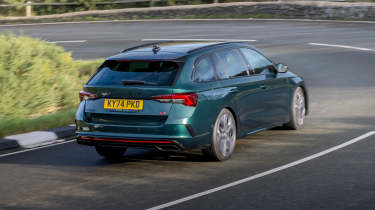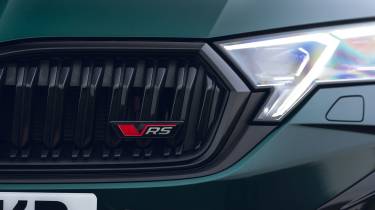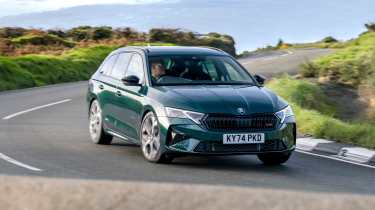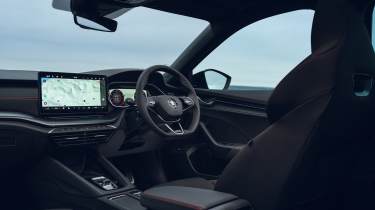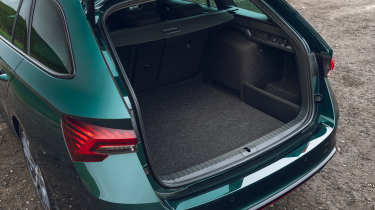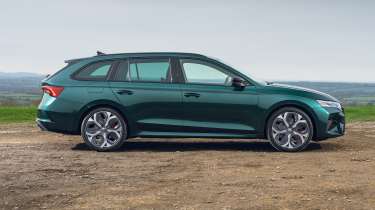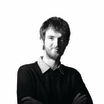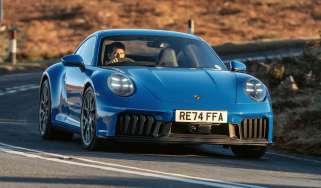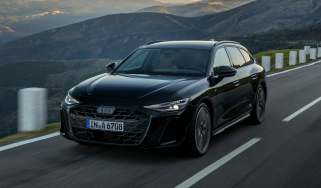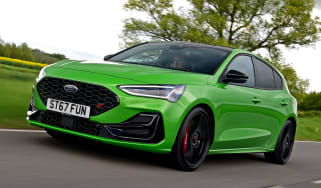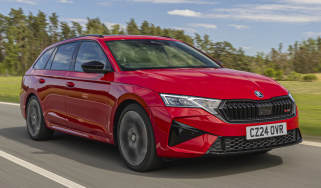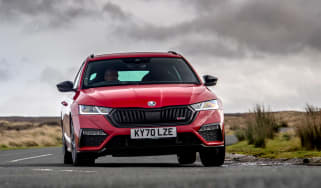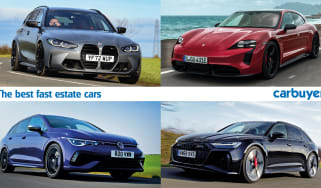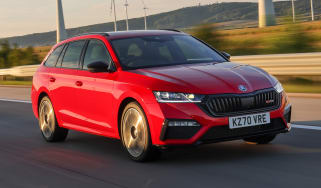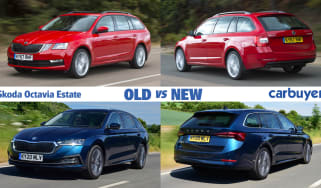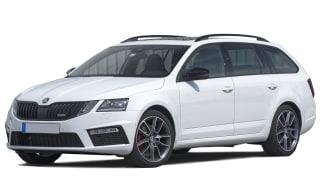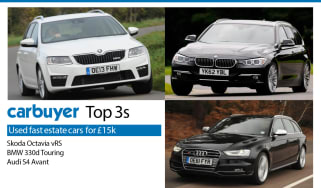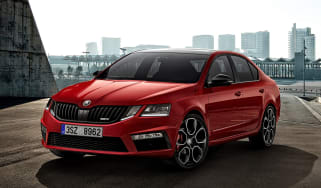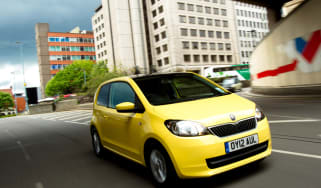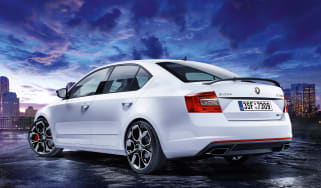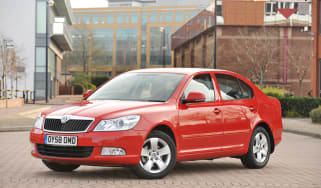Skoda Octavia vRS Estate review – performance and practicality in one car
“The Skoda Octavia vRS Estate offers great performance, technology, space and choice”
Pros
- Good to drive
- Huge boot
- Hi-tech interior
Cons
- PHEV is compromised
- More expensive than before
- Slower than rivals
Verdict – is the Skoda Octavia vRS Estate a good car?
The Skoda Octavia vRS Estate has come back fighting since its facelift, with even more power, some tweaked looks and just as much class-leading space as before, making it a performance estate that’s very easy to live with. It’s very poised to drive and a great all-rounder, although admittedly many rivals are quicker, and some keen drivers might miss the option of a manual gearbox.
Skoda Octavia vRS Estate models, specs and alternatives
After a short hiatus, the Skoda Octavia vRS Estate has returned with its enticing blend of sportiness and performance as well as class-leading practicality and everyday usability. It has also emerged from its cocoon with sharper styling and new matrix LED headlights to keep it up to date and looking modern, just like the rest of the Octavia lineup.
The interior has also got significant changes, most noticeably a 13-inch tablet-style touchscreen. There’s improvements to the interior trim and upholstery and a 15-watt wireless smartphone charging pad, as well as a 10-inch digital driver’s display. Unique to the vRS, of course, are sporty styling upgrades such as more muscular bumpers front and back, black exterior trim pieces replacing the chrome-effect elements from lesser cars, and 19-inch alloy wheels for an aggressive stance.
Previously, there was a Skoda Octavia vRS iV Estate, which offered a plug-in hybrid set-up with a rechargeable battery and a petrol engine, but this was long phased out. It would be a good option for those who can charge at home and make use of the short electric-only range for commuting, so it’s worth looking for a used example if that appeals to you.
More reviews
Following the facelift, the Octavia vRS’s 2.0-litre petrol engine is now tuned up to 261bhp – in line with that of the latest Golf GTI. The only option is now a seven-speed DSG automatic gearbox, though, so avid manual drivers might be disappointed. There’s no longer a diesel option like there was before, so the petrol is your sole option in the vRS.
Predictably, performance figures have also seen an improvement, so now the Skoda Octavia vRS Estate can do the sprint from 0-62mph in 6.5 seconds – that’s two tenths of a second quicker than before, although bear in mind the hatchback variant is one tenth of a second quicker still.
The vRS isn’t the most exciting hot estate car out there; the Focus ST Estate is more fun to drive and there are more expensive offerings like the Volkswagen Golf R Estate that boast even better performance. However, the Skoda offers a brilliant blend of practicality, fun and best of all, it represents pretty good value as well.
MPG, running costs & CO2
With its turbocharged 2.0-litre petrol engine, the vRS manages middling efficiency figures, returning up to 40.4mpg and emitting 159-163g/km of CO2.
It’s a shame the 2.0-litre diesel model is no longer offered, because it returned up to 55.9mpg while producing 133g/km of CO2 with front-wheel-drive or 50.4mpg and 147g/km of CO2 if you specified four-wheel-drive. High CO2 emissions put petrol and diesel versions in fairly high Benefit-in-Kind tax brackets for business users.
A plug-in hybrid Skoda Octavia vRS iV was previously available, although it was phased out of the range during the latter stages of the pre-facelift car’s life. It was a great option for company car drivers or people with a relatively short commute, so it would be good to see it reappear at some point.
Up to 37 miles of silent electric running was possible, and the tiny 27-29g/km CO2 figure was appealing to company-car drivers eyeing up a vRS. Skoda’s claimed economy figure of up to 235mpg shows what might be achievable, but again this depends on the journeys you do and how often you top the battery up.
VED (car tax) costs the standard rate each year, but cars costing more than £40,000 after options will also incur the additional annual surcharge until they’re six years old. Skoda offers a pretty standard three-year/60,000-mile warranty, and you can buy service plans upfront or spread the cost out monthly.
Engines, drive & performance
Following the Skoda Octavia vRS’s facelift, its 2.0-litre turbocharged engine is now capable of a more potent 261bhp – that’s 19bhp more than before and in line with the latest version of the Volkswagen Golf GTI.
That’s made the latest Octavia vRS Estate two-tenths of a second quicker from 0-62mph, so now it does that sprint in 6.5 seconds. The lighter weight of the hatchback means it will do the same in 6.4 seconds. The Octavia vRS is now only available with a seven-speed DSG automatic transmission – it’s a quick, responsive and well tried-and-tested gearbox, but some keen drivers might lament the loss of the six-speed manual in terms of driving engagement.
Overall, though, we think the Octavia vRS Estate actually feels better to drive in many ways compared to the – dare we say it – regular Golf GTI. That’s because the wheelbase is longer, which when combined with the sports suspension and slightly heavier weight of the Octavia vRS, makes it feel a little more planted. Admittedly, the Golf GTI is quicker on paper, but the Octavia vRS is controlled and yet comfortable, with lots of steering feedback, making it rewarding to drive.
Interior & comfort
Inside, the new Octavia vRS looks more futuristic than the previous generation, thanks to a sleek two-spoke steering wheel and a large floating touchscreen. You do have to access the climate control through the screen but Skoda has provided a place to rest your wrist on the full-width trim piece intersecting the dashboard. The vRS-specific touches include a flat-bottomed wheel, red ambient lighting and sports seats, and it looks a little more restrained than the Ford Focus ST estate.
Post-facelift revisions mean the Octavia vRS Estate now gets a 13-inch infotainment screen, upgraded interior trim and upholstery compared to before, a 15-watt wireless smartphone charging pad and a 10-inch digital driver’s display among other features.
Options include adjustable suspension, a panoramic sunroof, a head-up display, an electrically powered tailgate, heated seats, a rear parking camera, wireless smartphone charging, and plenty of neat extra gadgets to increase practicality and comfort on the inside, such as boot net partitions and the ‘sleep pack’ which adds headrests that fold and contort to support passengers heads when they nod off.
Practicality & boot space
Skoda didn’t need to make the Octavia’s boot any bigger - it was already class-leading - but the new car is even more cavernous. The boot capacity isn’t affected in the vRS models, so you get 640 litres to fill. That’s the same as the Mercedes E-Class estate, which is class-leading itself and a bigger car than the Octavia.
At least there’s room for your passengers to stretch out, regardless of the engine you pick. Unlike most estates this size, the Octavia vRS allows three adults to sit side-by-side across the back row. There are an array of storage areas, plus Skoda’s Simply Clever touches like a parking ticket holder and an integrated ice scraper.
Reliability & safety
It’s almost hard to believe that Skodas were mocked just a couple of decades ago; more recently they’ve become customer favourites and tend to score highly in our Driver Power owner satisfaction survey, although in the more recent editions the results aren’t so impressive. That said, the brand still comes ahead of most of its sister brands, finishing in 23rd out of 32 manufacturers, while SEAT came 24th, Audi came 27th and Volkswagen came 29th. Performance spinoff of SEAT, Cupra came ahead in 18th place.
The Octavia itself came in 66th out of the top 75 cars rated in 2022, but didn’t appear in the results in 2023 or 2024. While owners were unimpressed with the Octavia’s driving feel, ride, handling, and gearbox smoothness, that shouldn’t necessarily apply to the more niche vRS variant. Elsewhere it scored well for boot space, which is definitely something carried over to the vRS Estate. A middling 23.7% of Skoda owners as a whole reported a fault with their cars within the first year, so while reliability might not be terrible, it’s not exceptional either.
A five-star score from crash-test body Euro NCAP means the car is very safe. It scored 92% for adult protection and 88% and 79% in the child protection and safety assist categories respectively. Standard safety equipment is good, as you get collision avoidance, lane-departure assist and oncoming traffic warning.


